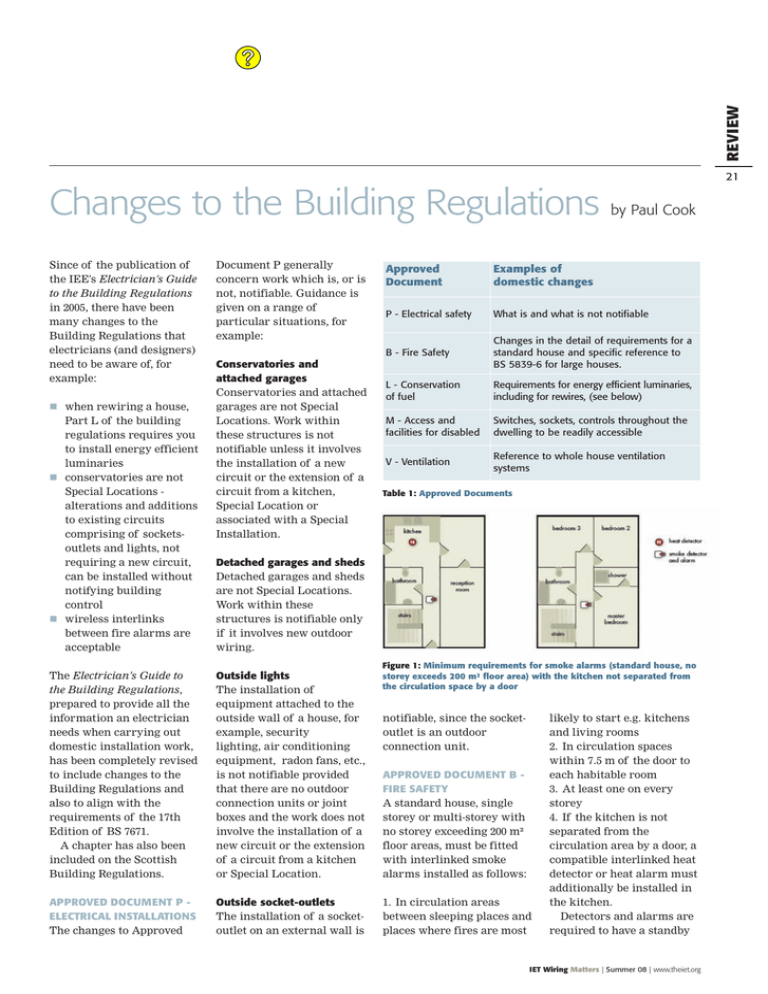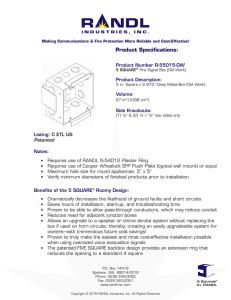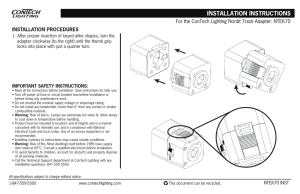Changes to the Building Regulations
advertisement

REVIEW 21 Changes to the Building Regulations Since of the publication of the IEE's Electrician's Guide to the Building Regulations in 2005, there have been many changes to the Building Regulations that electricians (and designers) need to be aware of, for example: when rewiring a house, Part L of the building regulations requires you to install energy efficient luminaries conservatories are not Special Locations alterations and additions to existing circuits comprising of socketsoutlets and lights, not requiring a new circuit, can be installed without notifying building control wireless interlinks between fire alarms are acceptable Document P generally concern work which is, or is not, notifiable. Guidance is given on a range of particular situations, for example: Conservatories and attached garages Conservatories and attached garages are not Special Locations. Work within these structures is not notifiable unless it involves the installation of a new circuit or the extension of a circuit from a kitchen, Special Location or associated with a Special Installation. by Paul Cook Approved Document Examples of domestic changes P - Electrical safety What is and what is not notifiable B - Fire Safety Changes in the detail of requirements for a standard house and specific reference to BS 5839-6 for large houses. L - Conservation of fuel Requirements for energy efficient luminaries, including for rewires, (see below) M - Access and facilities for disabled Switches, sockets, controls throughout the dwelling to be readily accessible V - Ventilation Reference to whole house ventilation systems Table 1: Approved Documents Detached garages and sheds Detached garages and sheds are not Special Locations. Work within these structures is notifiable only if it involves new outdoor wiring. The Electrician's Guide to the Building Regulations, prepared to provide all the information an electrician needs when carrying out domestic installation work, has been completely revised to include changes to the Building Regulations and also to align with the requirements of the 17th Edition of BS 7671. A chapter has also been included on the Scottish Building Regulations. Outside lights The installation of equipment attached to the outside wall of a house, for example, security lighting, air conditioning equipment, radon fans, etc., is not notifiable provided that there are no outdoor connection units or joint boxes and the work does not involve the installation of a new circuit or the extension of a circuit from a kitchen or Special Location. APPROVED DOCUMENT P ELECTRICAL INSTALLATIONS The changes to Approved Outside socket-outlets The installation of a socketoutlet on an external wall is Figure 1: Minimum requirements for smoke alarms (standard house, no storey exceeds 200 m² floor area) with the kitchen not separated from the circulation space by a door notifiable, since the socketoutlet is an outdoor connection unit. APPROVED DOCUMENT B FIRE SAFETY A standard house, single storey or multi-storey with no storey exceeding 200 m² floor areas, must be fitted with interlinked smoke alarms installed as follows: 1. In circulation areas between sleeping places and places where fires are most likely to start e.g. kitchens and living rooms 2. In circulation spaces within 7.5 m of the door to each habitable room 3. At least one on every storey 4. If the kitchen is not separated from the circulation area by a door, a compatible interlinked heat detector or heat alarm must additionally be installed in the kitchen. Detectors and alarms are required to have a standby IET Wiring Matters | Summer 08 | www.theiet.org REVIEW 24 power supply, for example, a battery or capacitor. The interconnection may be by radio links. See fig 1. of an installation for a standard house, where no storey exceeds 200 m² floor area, with the kitchen not separated from the circulation space by a door PART L - CONSERVATION OF FUEL AND ENERGY In new buildings, extensions and rewires to existing buildings, the minimum number of fixed energy efficient light fittings must be either: 1. One per 25 m² of the floor area, excluding garages, or 2. One energy-efficient light fitting per four fixed light fittings. Energy efficient fittings are fixed light fittings that can only accept lamps with a luminous efficacy exceeding 40 lumens per circuit-watt, such as compact fluorescent lamps. Lamp holders which accept Edison screw or bayonet lamps do not, unless they are of a certain unique nonstandardised type made to accept only lamps of the required efficacy. The lamp holder must not accept lamps of a lesser efficacy than that specified. PART M - ACCESS AND FACILITIES FOR THE DISABLED The Building Regulations are now understood to require switches, socket-outlets and controls in dwellings to be installed so that all persons, including those whose reach is limited, can easily use them. One way of satisfying the requirements is to install switches, socket-outlets and controls throughout the dwelling in accessible positions; detailed guidance is given. It is also worth noting Part C, Airtightness and Part E, Acoustics, since each of these can impose requirements on the installation of, for example, luminaires. In the case of Part C (see BS 9250 Code of practice for the design of airtightness of ceilings in pitched roofs), it may be necessary to make good the breaching of an acoustic barrier between, for instance, flats and could, therefore, affect the installation of wall mounted socket-outlets, switches, luminaires, etc., in both walls and ceilings. 17TH EDITION OF BS 7671 The Electrician's Guide to the Building Regulations has been completely revised to reflect changes in both the Building Regulations and the Wiring Regulation. Perhaps the most significant changes in the 17th Edition are the requirements for RCDs. Additional 30 mA RCD protection is required in dwellings for: all socket outlets for general use, all bathroom circuits, all circuits with cables buried in walls at a depth less than 50 mm unless protected by an earthed metal sheath, steel conduit or similar all circuits supplying IET Wiring Matters | Summer 08 | www.theiet.org Figure 2: Split consumer unit with separate main switch and two 30 mA RCDs, suitable for all installations Lighting Other uses (i) Low voltage installations supplied directly from a public low voltage distribution system 3% 5% (ii) Low voltage installations supplied from private LV supply (*) 6% 8% (*) The voltage drop within each final circuit should not exceed the values given in (i). Where the wiring systems of the installations are longer than 100 m, the voltage drops indicated above may be increased by 0.005% per metre of the wiring system beyond 100 m, without this increase beng greater than 0.5%. The voltage drop is determined from the demand by the current-using equipment, applying diversity factors where applicable, or from the value of the design current of the circuit. Table 2: Voltage drop mobile equipment outdoors all circuits with cables installed in walls or partitions of metallic construction. The Guide provides a range of solutions, for example, see fig. 2. DISCONNECTION TIMES For TN Systems, a 0.4 s disconnection time is required for all final circuits up to 32 A rating with a 5 s disconnection time allowed for distribution circuits and final circuits of rating exceeding 32 A. VOLTAGE DROP The requirements are deemed to be satisfied if the voltage drop between the origin of the installation (usually the supply terminals) and any socketoutlet or the terminals of fixed current-using equipment does not exceed the following, see table 2. The book is a must for all electricians and designers. The Electrician’s Guide to the Building Regulations (2nd edition) will be published in the summer.



